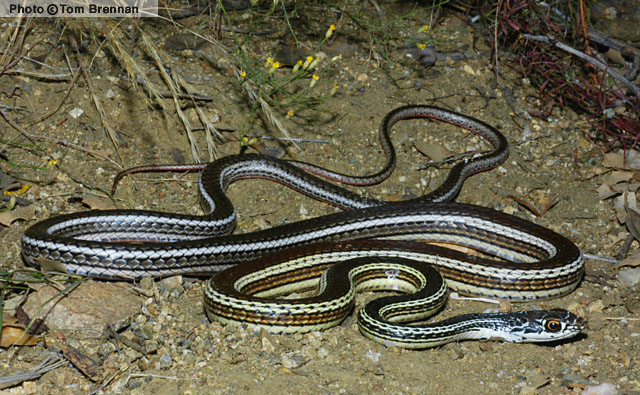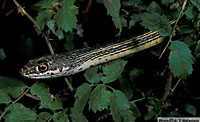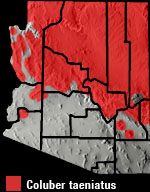Online Field Guide to The Reptiles and Amphibians of Arizona



La Paz County, AZ
 Apache Co., AZ |
| STRIPED WHIPSNAKE Coluber taeniatus |
Non-Venomous
|
| DESCRIPTION: A long (up to 1,652 mm or 65″ in total length), slender, dark brown, gray, or black snake with a prominent light stripe running the length of the body along each upper side. Thin, dashed, secondary stripes mark the lower sides. The primary stripes are yellow on the anterior portion of the body and grade to pale gray on the posterior half of the body. A thin black line runs down the center of each primary stripe on the anterior half of the body. The ventral surface is cream or white under the chin and neck, grading to yellow at mid-body, and dark pink under the tail. The eyes are large and the pupils are round. The scales are smooth. Stripes that run the length of its body and dark pink coloration under its tail distinguish this snake from the similar looking Sonoran Whipsnake.
DISTRIBUTION: This snake is an inhabitant of Arizona’s northern plateaus and central mountains. Isolated populations occur in the Kofa Mountains of Yuma County and in Graham County‘s Santa Teresa and Pinaleño mountains. It is found at elevations ranging from 2,800′ to about 7,500’. HABITAT: The Striped Whipsnake is primarily an inhabitant of Interior Chaparral, Great Basin Conifer Woodland, Plains Grassland, and Great Basin Grassland communities. It also enters the lower reaches of Petran Montane Conifer Forest in some areas. In the Kofa mountains of Yuma County it occurs in Arizona Upland Sonoran Desertscrub. It inhabits a wide variety of terrain types including canyons, steep slopes, foothills, open plains, open plateaus, and riparian corridors.BEHAVIOR: This diurnal, very fast moving, and alert snake is often seen cruising for food in the mid-morning sun. It often hunts with its head elevated off the ground. It is a good climber that often retreats into the branches of trees when threatened. It hibernates during the cold months of late fall and winter. It does not hesitate to bite when captured.DIET: It actively forages for lizards, snakes, mice and other small mammals, birds, frogs, and a variety of insects.REPRODUCTION: Mating takes place in spring and a clutch of up to 12 eggs is laid in late spring or early summer. Hatchlings begin to emerge in August. By Thomas C. Brennan Bartlett. 2000. Snakes of North America: Western Region. Gulf Publishing Co. Houston, TX Brennan, T. C., and A. T. Holycross. 2006. A Field Guide to Amphibians and Reptiles in Arizona. Arizona Game and Fish Department. Phoenix, AZ Brennan, T. C., and A. T. Holycross. 2005. A Field Guide to Amphibians and Reptiles of Maricopa County. Arizona Game and Fish Department. Phoenix, AZ Degenhardt, W. G., Painter, C. W., and Price, A. H.. 1996. Amphibians and Reptiles of New Mexico. University of New Mexico Press. Albuquerque. Fowlie. 1965. The Snakes of Arizona. Azul Quinta Press, Fallbrook, California Stebbins. 1985. Western Reptiles and Amphibians. Houghton Mifflin. New York, NY |
|
Visit Partners in Amphibian and Reptile Conservation:


HOME
Copyright © 2023, Arizona Game and Fish Department. All rights reserved.
If you make use of the textual contents of this site in reports, publications, etc. please cite and credit the author(s) and photographer(s). All photos on this website are copyrighted. However, those found in the species account section may be used for any noncommercial scientific, educational, or conservation purposes provided that photographs are not altered and continue to bear the copyright symbol and name of the photographer. Please contact the photographer regarding commercial use of copyrighted photographs.











